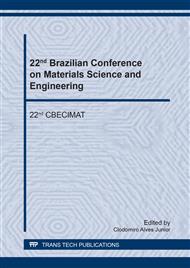p.478
p.484
p.489
p.495
p.501
p.507
p.513
p.520
p.526
Microstructure Optimization in δ-TRIP Steels with Al and Nb
Abstract:
δ-TRIP steel is a recent concept and has been developed over the last ten years aiming to combine good mechanical strength and ductility. This class of steels is multiphase and contains δ and α ferrites, as well as austenite, bainite and/or martensite. The TRIP (Transformation Induced Plasticity) effect is influenced by those phases proportion, which depends on alloying contents. This paper investigates a chemical composition that allows adequate proportion among the phases, optimizing the microstructures by means of computational methods. These microstructures are designed to contain between 10 to 50% austenite, 10 to 70% α-ferrite and 20 to 80% δ-ferrite at the eutectoid temperature. The ThermoCalc Software [1] was used to predict the fractions of the microconstituents, producing graphs describing areas of interest of microconstituents as function of alloying elements variations that leads to the desired microstructure. Results indicate that the designed volume of the phases can be found for certain proportions among the alloying elements, higher concentrations of Al and Nb combined with C allow or not the occurrence of carbides and other phases in smaller quantities.
Info:
Periodical:
Pages:
501-506
Citation:
Online since:
September 2018
Keywords:
Price:
Сopyright:
© 2018 Trans Tech Publications Ltd. All Rights Reserved
Share:
Citation:


